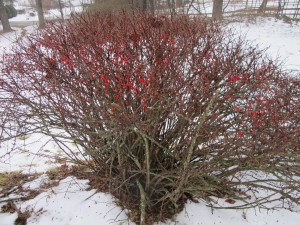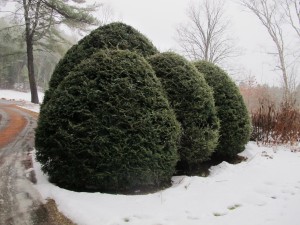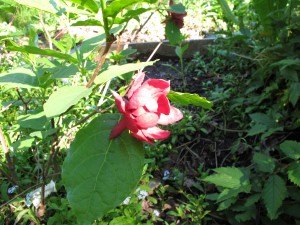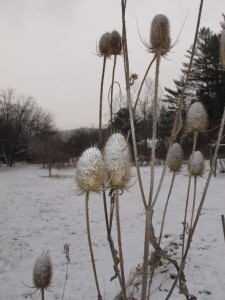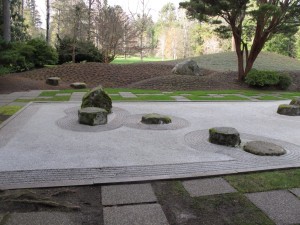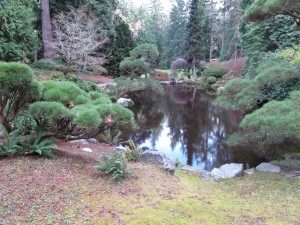Consider the Birds
Even Ebenezer Scrooge, (at least in his post-enlightenment days) probably had a bird feeder. Virtually everyone I know does, at any rate. Why? Because live birds are fun to watch, colorful, and because we pity them on cold mornings. Ten below zero? Those little chickadees are puffed up and fat-looking, increasing their tolerance to the cold by fluffing up their feathers. They seem to rely on us for food, but in fact, what we provide is more like dessert.
According to some studies, in winter birds only get about 25% of their calories from seed we buy. Maybe less. All year long they eat seeds, bugs, berries, nuts and all sorts of scavenged food. But we can help them by planting shrubs and trees that provide high calorie, nutritious food. Which is to say we shouldn’t be planting Fruit Loops – or the equivalent – we should be planting native species that are the equivalent of oatmeal or other healthy foods.
If you wish to plan on planting some bird-friendly plants, there is a wonderful book to help you: Richard DeGraaf’s Trees, Shrubs and Vines for Attracting Birds (University Press of New England, 2nd edition 2002, paper). It lists more than 160 woody plants used by birds and lists the birds that use each for food, cover or nesting.
A friend of mine has a barberry hedge and since barberries are on the invasive species list, I’d love to see the backhoe come next spring to pull those prickly shrubs out by their roots. I see barberries throughout the woods and at the edges of the fields – planted by the birds, and taking over the understory.
So what would I substitute as a hedge? Looking though DeGraaf’s book, I see plenty of shrubs that would serve the birds better. Common barberry (Berberis vulgaris) is eaten by just 7 species of birds. Highbush blueberry, on the other hand, is eaten by 52 species of birds, according to his book. But some might note that barberries persist during the winter (they are not very palatable to most birds), so they can serve as emergency rations.
But there are native species that also have berries that persist for most of the winter, but will not take over the undergrowth and squeeze out other species. There are plenty of viburnums that have good berries, some of which persist into winter. Viburnums, in general, are fast growing shrubs with nice flowers and berries. I particularly like one called Viburnum sargentii ‘Onodaga’ that has spectacular clusters of white blossoms in early summer. On the downside, however, there is an insect pest a beetle – that is killing or damaging some viburnums, so check at your family-owned, local nursery to find which species are susceptible to the beetle before buying.
And there is of course, the common cranberrybush viburnum (V. opulus) which produce masses or red berries that persist into winter. DeGraaf’s book lists 31 birds that eat the berries, including several thrushes, bluebirds, catbirds, bluejays, flickers and flycatchers. Definitely a better hedge than barberry.
Our native dogwoods of various sorts are attractive to birds, and some are fast-growing and suitable to use as hedges. Redosier dogwood (Cornus sericea) does best in wet spots, but will grow in ordinary garden soil, too. It spreads by root, so it will fill in to form a hedge in no time. The bright red (or yellow) stems of new growth can be spectacular for winter viewing. Some 20 species of birds eat the fruit.
Full sized trees are important to birds, too. They can provide shelter, nesting sites and food. Two common evergreens are among the best: white pine and Canadian hemlock. White pines provide food for 46 species of birds, and almost as many use them for nesting and cover. They are easy to grow and tough – just keep them well away from salted roads, as salt can kill them.
Canadian hemlock is the preferred nesting site for robins, blue jays and wood thrushes, among others. The seeds are good winter food for juncos, chickadees, goldfinches, blue jays and others. And unlike pines, one can use them to create hedges. That said, many people start out using hemlocks for hedges, only to get lazy for a few years – and discover that their hedge is 12 feet tall! That’s delightful to the birds, but may not give you the size hedge you wanted.
Apples, crabapples and nut trees are good for birds, too. Not all crabapples appeal to birds, but some favorites include Snowdrift, Sugar Time, Indian Magic, Sargent, Red Jewel, Prairie Fire and Golden Rainbow. Even hard nuts are helpful – often after squirrels finish with them there are tasty tidbits left in the shells for birds.
Almost anything you plant will provide something for the birds, but do your homework this winter to see what would please both you and the birds.
Henry Homeyer can be reached at henry.homeyer@comcast.net. His web site is www.Gardening-guy.com. He is the author of 4 gardening books.
Exploring New Trees and Shrubs
Snow has come. The leaves are raked. The garden is as put to bed as it’s going to get. It’s a good time to think about what worked this year and what didn’t. I was pleased with a number of new shrubs that I planted in the last two years and think you might like to keep them in mind next spring when the ground thaws.
The very last shrub that I planted this year was – I have to admit- an impulse buy: scarlet beauty sweetspire (Itea virginica ‘Morton’). I was at E.C. Brown’s Nursery in Thetford, VT (www.ecbrownnursery.com) in mid-November to get a small tree for a special project. And there by the driveway was a shrub that still had its leaves, and they were bright red! I mean as red as burning bush (Euonymus elata) that shrub, loved by many but now banned in most states, that turns a brilliant red in fall. It called to me a soft voice,”I could be yours. I need a home before winter …” So it came home.
According to the tag, it is a medium growing spreading deciduous broadleaf shrub with a height of 3 to 4 feet that spreads 2 to 4 feet. Before I decided on it, I checked my favorite plant reference text, Michael Dirr’s Guide to Woody Landscape Plants. It told me that it is hardy to Zone 5 –safely surviving winters of minus 20 degrees. The plant tag said it was hardy to Zone 4, which means it will survive 30 below zero. I decided to get one, even though we do see temperatures colder than 20 below, on occasion.
Dirr’s book also described the flowers as white, lightly fragrant and about half an inch in diameter, blooming in early summer. He noted that given full sun and plenty of moisture the flowering can be “staggeringly beautiful”. That sounded good to me. Especially since the leaves were dramatic in their fall colors – and I have a nice wet spot near my stream. I am always leery of plants that spread by root, so I ‘ll keep an eye on this one to be sure it doesn’t take over.
Another nice shrub that I got in 2012 that had great fall foliage is the “redbud hazel” (Disanthus cercidifolius). Not a redbud or a hazel, this shrub has leaves that look like redbud leaves. The leaves turn a brilliant red early in the fall, with hints of orange and purple. I planted mine in 2012 and it overwintered nicely, but did not bloom this year. Though as I read Dirr’s book, I now notice that the flowers are “non-showy” half-inch diameter dark purple flowers that appear in October. So maybe there were a few, and I missed them in among the red foliage.
Redbud hazel plants need light to moderate shade, along with deep moist soil that is rich in organic matter and protection from the wind. Mine is suitably planted, and has survived minus 20 degrees. They can grow 6 to 10 feet tall, though mine did not show rapid growth in its first year.
Another nice shrub that I planted in 2012 has many names: Carolina allspice, common sweetbush, sweet Bettie, spicebush and my favorite, sweet bubby. Which is. of course, why plant geeks like me prefer the Latin name: Calycanthys floridus. Don’t be intimidated by Latin nomenclature, just pronounce every letter – and say it with gusto and everyone will be sure you know what you are talking about (that works for me, anyway).
Sweet bubby is, according to the literature, very adaptable: it will grow in sun or shade, acid or alkaline soil. But it does like rich, moist soil and I have plenty of that. I originally planted it in full sun, but the leaves scorched a little that first summer. I assumed that since I had kept it in the pot in a shady spot for a month or more, the scorching was just a reaction to the sudden shift to full sun. But it scorched again this year. So this fall I moved it to light shade near a big old wild apple tree.
The flowers of Calycanthus are striking: deep maroon up to 2-inches across and they can be deliciously fragrant. But not all varieties are fragrant, so if the scent is important to you, buy in early summer when the blossoms are on the plants at the nursery. Some, I have read, may even smell like vinegar. Mine do not have a noticeable fragrance.
I have seen a Calycanthus that was 8 feet tall I in Woodstock, VT, but it was clearly a plant that had been around a long time. Mine has not grown much in the two years I have had it. It can spread 6 to 12 feet, and the two specimens I see regularly seem to be more interested in growing sideways than getting tall.
The only other woody plants I installed this year were a couple of striped or moose maples (Acer pennsylvanicum). This is a small understory tree that I notice in the woods in winter – the bark turns a bright, light green with dark stripes. It is rarely sold in plant nurseries, so grab one if you see it for sale. It is said to grow even in terrible soil conditions, but likes moisture and acidic soil.
We can’t plant anything now, but we can plan and dream.
Henry Homeyer is the author of 4 gardening books and a children’s fantasy-adventure about a boy and a cougar. His web sites are www.henryhomeyer.com and www.gardening-guy.com. He can be reached at PO Box 364, Cornish Flat, NH 03746 or henry.homeyer@comcast.net.
Holiday Decorations
This time of year is tough on many gardeners: there is little daylight and little to do in the garden. And there are no flowers to pick and place on the table. Recently the weather has been dismal: dark gray days with precipitation off and on. Over the centuries people have combated the darkness with candles, bonfires, holiday lights and sprigs of greenery placed on the door or brought inside. Let’s look at what we can do.
First, I regularly visit my local independent florist. Florists are a dying breed, along with independent bookstores and family-owned hardware stores. Call me an old codger, but I believe that there is value in supporting all of these institutions, even if I pay a dollar or two more for what I buy. The owners of these institutions have a wealth of knowledge, and are happy to help you find just what you need. And often their prices and quality are actually better.
For example, I believe that the flowers I get from my florist last longer and look better than flowers bought at a big box store. I ask my florist to put together a bouquet of flowers for me, and she picks a nice selection – $10 will usually buy a generous bouquet.
Keeping the bouquet fresh takes regular maintenance: I change the water every day or two, and trim off half an inch of stem each time. It’s also important to remove all leaves that might get into the water. When the leaves die, bacteria grow and slime forms – blocking the uptake of water to the flowers. So they wilt.
A few years ago I called my florist to see if she had any potted phalaenopsis orchids for sale. Surprisingly, she told me to go to a big box store, and I did. I was amazed to see them for sale under $15. Certain big box stores obviously have suppliers who sell them truck loads of these hardy and gorgeous orchids. So most florists don’t even try to compete.
Phalaenopsis orchids are relatively easy to maintain and can be coaxed to produce more blossoms in future years. They want bright diffuse light: a table top in a bright room is fine. The key is to avoid overwatering. These orchids are sold growing in a fast-draining bark mixture without soil. The roots are in a plastic mesh pot with holes which sits inside a ‘cache’ pot that has no drainage hole. I lift the inner pot out of the outer, and allow water to run through the bark chips once a week. I allow it to drain, then return it to the cache pot. If you water the plant in the outer pot, it collects water at the base – eventually drowning your orchid.
I also scavenge twigs, branches, dry flowers and berries to add to flower arrangements, or to create arrangements in their own right. Each fall I cut hydrangea blossoms and store them in tall flower pots without water. They last well all winter.
Teasel is a dreaded weed for corn farmers in the Midwest, but I grow a few plants each summer and use it as a dry flower in winter arrangements. This plant is biennial, meaning that it blooms in its second year of life, and then dies. It gets to be over 6 feet tall and displays wonderful seed pods that have sharp barbs and spines. The key is to learn to identify the first year plants, so that you can weed out most of them before they mature.
Evergreen boughs are nice indoors at this time of year. Just be careful where you make your cuts. Never take the top of a small tree, or the tip of a prominent branch. Most do not replace the missing branch, or will send out several new branches instead of just one. So you can spoil the look of your evergreen by snipping branches carelessly. Cut inner branches, or take pieces from inconspicuous places.
Canadian hemlock is plentiful in woods everywhere, but the needles do not last well indoors. (Identify them by their short, flat needles). Your best bet is to buy a Christmas tree that is a little too tall – and the cut off branches at the base to use in vases or swags. White pine lasts well in a vase and is very common (Identify them by their 5 long, soft needles per cluster of needles, one for each letter in w-h-i-t-e).
Of the berries, the brightest and best looking is winterberry (Ilex verticillata), our native deciduous holly. These are understory trees or tall shrubs that grow wild in wet places and swamps, but also make satisfactory garden plants. They are dioecious, which means you need a boy bush to go with the females – or no berries. The berries are commonly sold by florists and grocers, and look great – though they tend to drop a few berries on the table before long. I don’t know how to keep that from happening. (Tell me if you do, please).
Last but not least, I am cheered up by outdoor winter lights. In recent years the industry has come up with LED lights that use almost no electricity – less than 5 watts a string instead of the 5 watts a bulb we had in my youth. So I place them in my garden on trees and shrubs and run them late into the winter. It’s all part staying cheerful while living in the Great North.
Henry Homeyer lives in Cornish flat, NH. You may reach him through his web sites: www.henryhomeyer.com or www.Gardening-guy.com.
Japanese Gardens
I recently visited an old college friend in Seattle, Washington and while out there we went to some nice gardens in the area. The Bloedel Reserve is on Bainbridge Island, a 30 minute ferry ride from downtown Seattle. It is a private 150-acre estate that was once the summer home and gardens of a wealthy Seattle family. The founder’s vision was “to provide refreshment and tranquility in the presence of natural beauty,”; the Reserve’s mission is to “enrich people’s lives through a premier public garden of natural and designed Pacific Northwest landscapes.”In my opinion, it meets its goals well.
The best part of the Bloedel Reserve, for me, is the Japanese garden. I have visited several Japanese gardens, and this one is a fine example of the style. It includes a tea house, a dry garden, a small flowing brook that enters a nice pond, large stones, lovely trees and flowers in season. Although I don’t aspire to create a Japanese garden, I recognize that many of the elements that are so attractive in a Japanese garden can be utilized in my own garden – or perhaps yours.
On the surface, at least, the easiest part of the Japanese garden is the dry garden, also called the flat garden or hira-niwa. Generally in Japanese gardens this is a space without vegetation: raked sand or fine gravel that is interspersed with stones of various sizes and shapes. To me, the fine gravel represents the sea and the large stones in it, islands. Some Japanese gardens include trees on islands in the dry garden, but this one did not. At Bloedel Reserve, the shape of the dry garden was rectangular, though I have to say I prefer the curves of others I have seen – they seem more natural. It is traditional to rake the sand or gravel regularly to create interesting patterns in it.
If I were to create a dry garden, I would certainly install a weed barrier beneath the gravel. I wouldn’t use plain black plastic – as effective as it is in keeping out weeds – as it would hold water. There are a variety of woven weed barriers that allow moisture to pass through, although some grasses and weeds can send roots through them. It’s important to have the dry garden flat.
It would be essential to have some kind of edging to keep grasses from creeping into the dry garden. Plastic edging exists in various forms – rolls, sections that interlock – but I have never found them easy to install or very effective at keeping out grasses. I like the “professional” edging made of steel or aluminum that comes in 10-foot sections and is held in place with metal pegs. It generally comes with a black painted surface. It is quite flexible, allowing one to create smooth curves, and can be installed using an edging tool or spade to cut through sod. Stone pavers would also work nicely.
Traditionally there is a tea house that overlooks the dry garden, and Bloedel was no exception. This is a place to sit and reflect on the tranquility of the gardens. The tea house has large glass panels on the side facing the dry garden, which create a visual frame for the dry garden from inside.
There are also benches throughout the gardens where one can sit and observe or ponder the state of the world. I think sitting places are important for any garden, the more comfortable the better. I have two stone benches in my gardens, but rarely sit on them for long – the stone is hard and often cold. But wooden ones, or wooden chairs, are more comfortable. And now days brightly colored Adirondack chairs in recycled plastic are not only comfortable, they are inexpensive – but not very Japanese.
Water is an important element of a Japanese garden, and traditionally they have both streams and ponds. The technology exists to create re-circulating streams and waterfalls, or to install a nice small plastic-lined pool. Goldfish or koi are an important element to small manmade pools, as they help to keep the water clean. At Bloedel a dry stream was created using stones “flowing” down a hillside.
The vegetation of any Japanese garden is important, too. Japanese red maples (Acer palmatum), rhododendrons, cherry trees and various evergreens, (particularly weeping evergreens) are commonly used for vertical elements. Weeping red maples stay small and can be very effective in Japanese gardens, but often are not hardy in Zones 3 and 4.
At Bloedel the perennial plants were largely dormant in late November, but I recognized the leaves of hellebores, decorative grasses, ferns, mosses and groundcovers.
It’s good, I think, to dream of garden projects, especially in these dark days of December. And who knows? Maybe I’ll decide to create a small Japanese garden next summer – but if you do, let me know as I’d love to visit it.
Henry Homeyer can be reached at P.O. Box 364, Cornish Flat, NH 03746 or henry.homeyer@comcast.net. His Web site is www.Gardening-guy.com.



